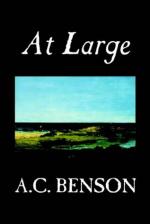“That is perfectly true,” I said. “But take an instance of another of Flaubert’s books, Bouvard et Pecuchet, where the same method is pursued with what I can only call deplorable results. Every detail is perfect of its kind. The two grotesque creatures take up one pursuit after another, agriculture, education, antiquities, horticulture, distilling perfumes, making jam. In each they make exactly the absurd mistakes that such people would have made; but one loses all sense of reality, because one feels that they would not have taken up so many things; it is only a collection of typical absurdities. Given the men and the particular pursuit, it is all natural enough, but one wearies of the same process being applied an impossible number of times, just as Flaubert was often so intolerable in real life, because he ran a joke to death, and never knew when to put it down. The result in Bouvard et Pecuchet is a lack of proportion and subordination. It is like one of the early Pre-Raphaelite pictures, in which every detail is painted with minute perfection. It was all there, no doubt, and it was all exactly like that; but that is not how the human eye apprehends a scene. The human mind takes a central point, and groups the accessories round it. In art, I think everything depends upon centralisation. Two lovers part, and the birds’ faint chirp from the leafless tree, the smouldering rim of the sunset over misty fields, are true and symbolical parts of the scene; but if you deal in botany and ornithology and meteorology at such a moment, you cloud and dim the central point—you digress when you ought only to emphasise.”
“Oh yes,” said Herries with a sigh, “that is all right enough—it all depends upon proportion; and the worst of all these discussions on points of art is that each person has to find his own standard— one can’t accept other people’s standards. To me Bouvard et Pecuchet is a piece of almost flawless art—it is there—it lives and breathes. I don’t like it all, of course, but I don’t doubt that it happened so. There must be an absolute rightness behind all supreme writing. Art must have laws as real and immutable and elaborate as those of science and metaphysics and religion—that is the central article of my creed.”




